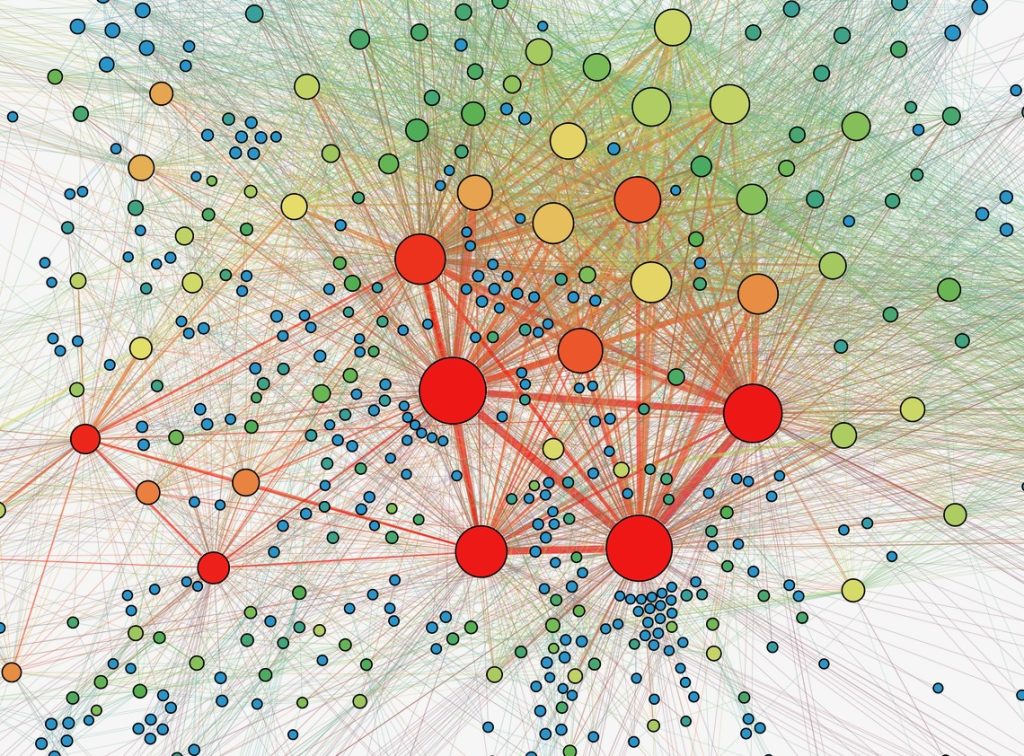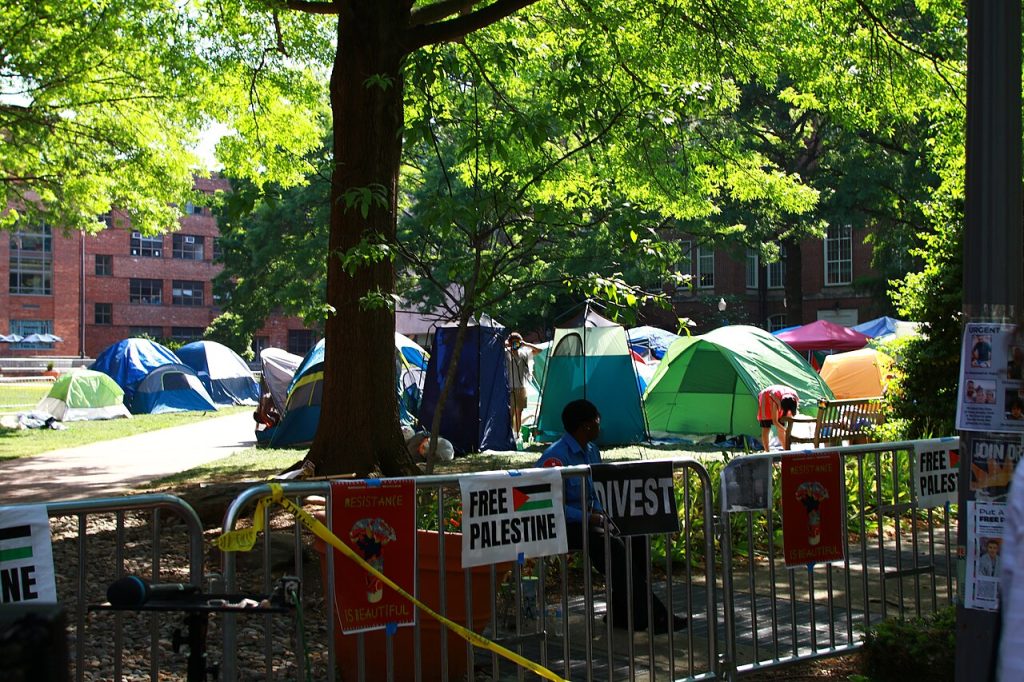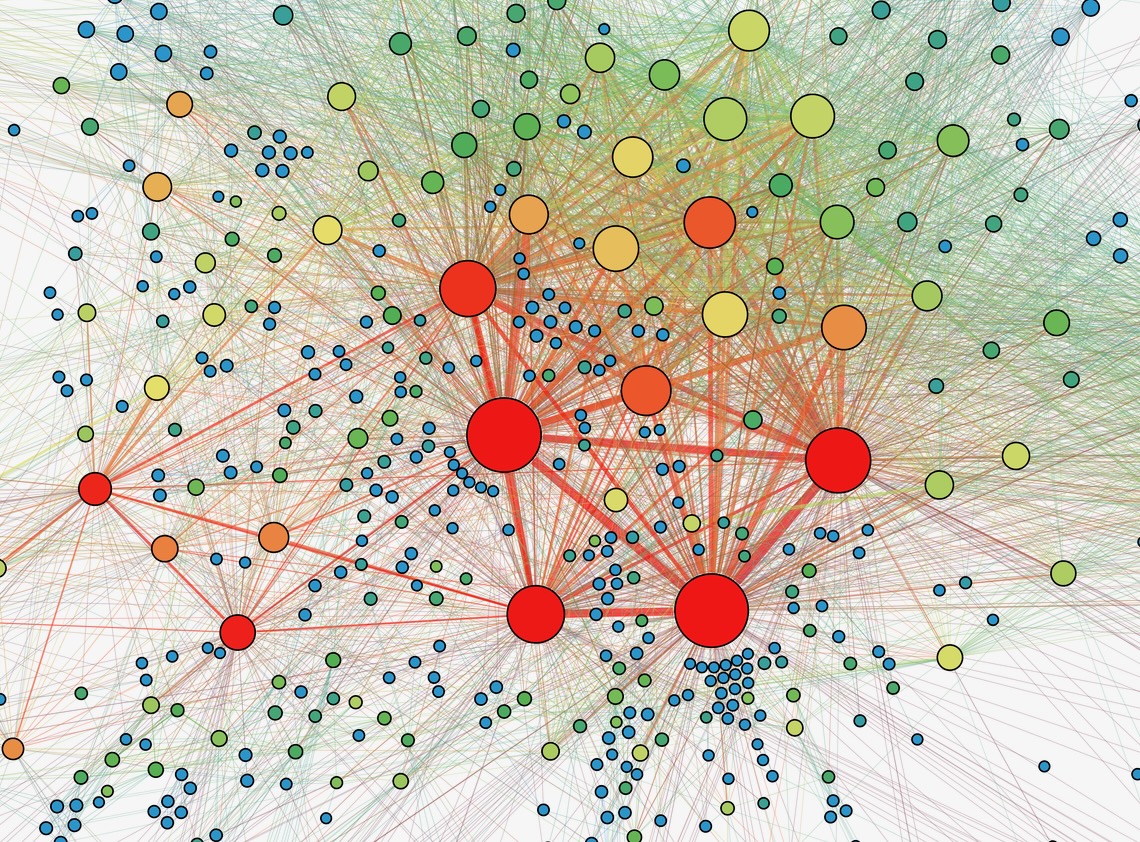By Matthew N. Lyons
The Israeli military’s ongoing genocidal campaign in Gaza, carried out with crucial US backing, has sparked worldwide protests, including thousands of rallies, vigils, sit-ins, blockades, occupations, and other actions across the United States. The forces of order in the U.S. have responded to this groundswell with an extensive campaign of political repression, violence, intimidation, and slander. Pro-Palestinian protesters have been assaulted, fired from their jobs, suspended from school, doxxed, and publicly vilified. Public officials and groups such as the Anti-Defamation League have falsely equated anti-Zionism (or even more limited criticisms of Israel) with antisemitism, despite the fact that many Palestine solidarity activists are Jews, and ignoring the deeply anti-Jewish beliefs motivating many pro-Zionists.
A major tactic in this backlash has been to blame pro-Palestinian initiatives on “outside agitators”—for example in claims that many campus protesters (or protest leaders) are non-students. In January, former speaker of the House of Representatives Nancy Pelosi suggested that some pro-Palestinian protesters were “connected to Russia” and called for an FBI investigation into their finances. Several Republican leaders, including Senator Ted Cruz and House Speaker Mike Johnson, have blamed the activism on funding by George Soros, the ubiquitous antisemitic scapegoat.
Now the Network Contagion Research Institute has published a report warning that “a network linked to the Chinese Communist Party” (CCP) is bankrolling much of the Palestine solidarity movement in the U.S., with results that promote “anti-American narratives,” undermine democracy, and threaten national security. Titled “Contagious Disruption: How CCP Influence and Radical Ideologies Threaten Critical Infrastructure and Campuses Across the United States,” the report warns of “a trend that has seen movements advocating for social justice employ increasingly aggressive tactics to disrupt public order and push the boundaries of foundational, legal, and ethical norms” and “a broader, more coordinated campaign influenced by entities that have ties to foreign powers and foreign terrorist organizations.”
Unlike Nancy Pelosi, the NCRI isn’t indulging in pure speculation here. There really is a money trail linking a CCP-aligned businessman in Shanghai with some pro-Palestinian organizations in the U.S.—just as there really is a money trail linking George Soros’s Open Society Foundations with any number of progressive groups. But like right-wing conspiracism, NCRI’s centrist conspiracism fundamentally misrepresents the nature of protest movements. Palestine solidarity in the U.S. is an essentially grassroots-based, popular mobilization encompassing a range of political actors. But in NCRI’s telling it’s a sleek vehicle driven by covert operators—malevolent outsiders who use their money to direct passive masses of people for their own ends.

Based at Rutgers University in New Jersey, the Network Contagion Research Institute has been described as “the world’s foremost expert in identifying and forecasting the threat and spread of misinformation and disinformation across social media platforms.” I wrote about NCRI for Three Way Fight in 2021, arguing that it combines seemingly sophisticated number crunching with a crude, system-serving analytic framework. Like the Anti-Defamation League or the Southern Poverty Law Center, the NCRI reduces supremacist politics to “hate” ideology, masking its roots in oppressive systems and dishonestly equating the far right and the radical left under the “extremist” label. I also highlighted the NCRI’s strong orientation toward bolstering law enforcement and the heavy representation of current or former security/police/military personnel among its staff and advisors. (About a year after my article was published, NCRI sharply reduced the cop/soldier presence on its team, but it has continued to focus largely on serving law enforcement.)
Back to Chinese Communist influence and pro-Palestinian activism. The NCRI’s “Contagious Disruption” builds on an August 2023 article in the New York Times, whose findings included the following:
- Neville Roy Singham is a wealthy American businessman with pro-Chinese politics, who since 2019 has run a Shanghai-based consulting firm with close ties to the Chinese government’s propaganda apparatus.
- Singham has distributed millions of dollars to organizations and projects in the U.S., Britain, India, Brazil, South Africa, and elsewhere that, as the Times put it, “mix progressive advocacy with Chinese government talking points.” A prominent example is Vijay Prashad’s think tank Tricontinental.
- Singham has concealed his donations by funneling the money through several U.S.-based non-profits that he controls indirectly, as well as the Goldman Sachs Philanthropy Fund, a donor-advised fund.
- In 2017 Singham married Jodie Evans, co-founder of Code Pink, which has received more than $1.4 million in Singham money since that year. Evans runs one of Singham’s non-profits and has reversed her previous sharp criticism of Chinese government repression.
To some extent, the NCRI’s “Contagious Disruption” report simply extends the Times exposé to address the pro-Palestinian movement in the U.S. The report focuses on the coalition Shut It Down For Palestine (SID4P), which formed soon after Hamas’ October 7, 2023, attack on Israel. NCRI notes that the organizations listed as SID4P “convenors” fall into two broad categories:
- People’s Forum, ANSWER Coalition, and International People’s Assembly are all closely associated (organizationally and/or financially) with the Party for Socialism and Liberation (PSL), whose affiliates also include Breakthrough Media.
- Al-Awda, National Students for Justice in Palestine (NSJP), Palestine Youth Movement, and Palestinian American Community Center in NJ are pro-Palestinian activist organizations independent of the PSL.
According to “Contagious Disruption,” PSL-affiliated groups have received substantial Singham funding, including over $20 million to the People’s Forum since 2017. (Jodie Evans sits on the People’s Forum board.) The NCRI report also finds that the PSL-associated groups have had a much more active social media presence around Palestine issues than the other SID4P convenor organizations.
These findings are all believable to me. Singham’s masked funding of leftist organizations was first alleged by the group Fashbusters in 2021, and People’s Forum admitted the connection soon after. But while the New York Times framed its reporting on Singham as a study in how pro-Chinese propagandists are attempting to influence the left, NCRI presents the issue as pro-Chinese propagandists directing the left. Here’s the NCRI report’s overall assessment:
The NCRI finds that the increase in direct-action, targeting infrastructure and public spaces, is in part driven by organizations connected to CCP foreign influence efforts. While nominally focused on Israel, the current protests can be better understood as a well-funded initiative driving a revolutionary, anti-government, and anti-capitalist agenda, with the leading organizations serving as versatile tools for foreign entities hostile to the U.S. The methods of these organizations exacerbate societal tensions, polarize the younger generation, and appear to seek the destabilization of American institutions. NCRI assesses that these organizations will persist in inciting unrest throughout the summer of 2024 and in the lead-up to the U.S. Presidential election. (Emphasis in original.)
In other words, never mind the mass-based nature of the protests in support of Palestine or the substance of what they are demanding—it’s all just a Chinese Communist plot to attack America.
To be clear, calling the NCRI’s analysis into question doesn’t mean endorsing the Chinese Communist Party or its supporters. Whatever its “socialist” pretensions, China is an authoritarian state that has criminalized strikes, subjected the Uyghur people to mass imprisonment and forced indoctrination, and suppressed independent organizing in Hong Kong. And funding questions aside, the PSL and its affiliates play a deeply problematic role within the U.S. left, from supporting mass-murdering dictators like Bashar al-Assad, to covering up sexual abuse, to offering media platforms to fascists and other far rightists. In addition, the PSL-affiliated group ANSWER “has joined with liberal coalitions to keep any radical voices other than PSL’s off the podium of anti-war rallies it initiates,” as Megan Cornish of the Freedom Socialist Party (a Trotskyist group) has written, pointing to a larger pattern of liberal sectarianism disguised as socialist militancy.
However, there are numerous problems with portraying the PSL et al. as “versatile tools” through which Chinese Communists direct the Palestine solidarity protests, as the NCRI’s “Contagious Disruption” report paints the situation. The NCRI exaggerates the PSL’s ability to control events, strips most movement participants of agency, and maligns radical politics in general. It also deflects attention away from Israel’s crimes and encourages fear-mongering toward China.
“Funding questions aside, the Party for Socialism and Liberation and its affiliates play a deeply problematic role within the U.S. left… But the NCRI exaggerates the PSL’s ability to control events, strips most movement participants of agency, and maligns radical politics in general. It also deflects attention away from Israel’s crimes and encourages fear-mongering toward China.”

Back in the 1950s and 60s, accusations of covert communist connections were used to discredit everything from the labor movement to Martin Luther King to, yes, campus anti-war protests. The fact that a centrist think tank is reviving this kind of scapegoating says a lot about the increasingly repressive political climate in the U.S. It also belies claims that racially tinged conspiracism is the exclusive province of the political right. Ethnic conspiracism often targets Jews, but anti-Chinese scapegoating goes back 150 years in U.S. history. Like Jews, Chinese people have often been portrayed as devious enemies with outsize power to manipulate people and events from behind the scenes. I’m sure the NCRI didn’t invoke such racist themes intentionally, but they must be reckoned with, especially since the Biden administration has continued many of Trump’s anti-China policies.
This isn’t the first time the NCRI has blamed militant mass activism on outside manipulators. As I noted three years ago, a 2020 NCRI report on “anarcho-socialists” promoted
the bogus claim…that the mass-based riots and violent anti-police activism that followed George Floyd’s murder in 2020 were instigated by a few leftist agitators. The report asserts that small groups of activists such as the Portland Youth Liberation Front were able to “mobilize lawlessness and violence” through sophisticated use of online communication to call up a “network-enabled mob” in numerous cities simultaneously. In other words, a think tank that claims to be combating the spread of harmful conspiracy theories is itself replicating a classic conspiracist myth that has been used to demonize leftists for generations.
Since my 2021 article about NCRI was published, at least two other glaringly bad publications from the institute have evoked sharp public criticism. On the theme of China, a December 2023 NCRI report claimed to uncover “a strong possibility” that TikTok was boosting and suppressing content to serve Chinese government interests—a finding that was widely cited by people who wanted TikTok in the U.S. to be banned or forcibly sold. But two “remarkably basic errors” in NCRI’s research rendered this finding useless, according to Paul Matzko at the libertarian Cato Institute: The researchers compared posts on TikTok and Instagram, but failed to account for the fact that Instagram had been operating twice as long as TikTok, and they failed to account for the substantial average age difference between Instagram and TikTok users.
Even more egregious was a July 2022 NCRI report on “Anti-Hindu Disinformation,” which alleged that “Hinduphobia is now exploding across entire Web communities” and that “State actors use Hinduphobic tropes as part of large scale information operations.” More specifically, the report claimed to find “evidence that Iranian trolls disseminated anti-Hindu stereotypes in an effort to inflame division and accuse Hindus of perpetrating a genocide against minorities in India.”
Hindus for Human Rights (HfHR) sharply criticized this report for falsely conflating bigotry against Hindus or Hinduism with opposition to Hindu nationalism, the fascistic movement that controls India’s government. HfHR pointed out that the vast majority of examples of “Hinduphobic disinformation” cited in the report were factually accurate criticisms of human rights violations in India, such as the persecution of Kashmiris and the mass killing of Muslims in the 2020 Delhi riots. HfHR also called out two of the report’s authors as officers of the Hindu nationalist-affiliated Hindu Students Council, and noted that failure to disclose these affiliations undermined the NCRI’s claims to be politically neutral and objective. Writing about this same NCRI report, Jewish Currents news editor Aparna Gopalan pointed out that NCRI’s portrayal of “Hinduphobia” directly follows the model that conflates antisemitism with any criticism of Israel.
It’s probably no coincidence that a think tank that whitewashes Hindu nationalism is also scapegoating India’s geopolitical rival. This aligns with the politics of the Biden administration, which has embraced Narendra Modi’s government while sharpening economic measures against China, and which has targeted political “extremism” in ways that broadly follow the NCRI playbook.
“A number of antifascists have rightly warned about red-brown politics, meaning the convergence or collaboration between sections of the radical left and far rightists… Yet opposition to red-brown politics can be used to bolster the legitimacy of the existing political order, demonize leftists, and fuel state repression. We need to confront both of these dangers, not give in to one in the service of combating the other.”
As I suggested above, the NCRI’s “Contagious Disruption” report, like the fearmongering and crackdowns against Palestine solidarity activism more broadly, point to an increasingly repressive political climate. This repression is being driven by both the right and the center, or by the dynamic interplay between the two. Sometimes the right leads and the center follows, as when Republican-led congressional investigations of supposed antisemitism helped spur universities to crack down on pro-Palestinian protests. But sometimes it’s the center’s actions against the right that fuel repression, as with the Biden administration’s use of dangerous legal tools such as seditious conspiracy charges to target far rightists implicated in the January 6th attack on the U.S. Congress—setting a legal precedent that will inevitably be used most forcefully against oppressed communities and the radical left.
For antifascists, the NCRI report also points to another double-edged political challenge. Over the past decade or so, a number of antifascists have rightly warned about the problem of red-brown politics, meaning the convergence or collaboration between sections of the radical left and far rightists, not because of an inherent affinity between the political “extremes,” as horseshoe theory postulates, but precisely the opposite—because of leftists abandoning liberatory principles. I addressed red-brown politics in 2015 and reviewed a major report about it three years later. Yet there’s another danger here: opposition to red-brown politics can be used to bolster the legitimacy of the existing political order, demonize leftists, and fuel state repression. We need to confront both of these dangers, not give in to one in the service of combating the other. The enemy of my enemy is not necessarily my friend, and that warning cuts both ways.
Thanks to Xtn Alexander for helpful comments and suggestions.
Photo Credits:
- Detail of “Social Network Visualization” by Martin Grandjean, from Martin Grandjean, “Introduction à la visualisation de données : l’analyse de réseau en histoire,” Geschichte und Informatik 18/19 (2015): 109-128. Image has been cropped. CC BY-SA 4.0, via Wikimedia Commons.
- George Washington University in Washington, D.C. pro-Palestinian encampment, April 28, 2024. Encampment, barriers, and signs reading “Free Palestine.” Photo by Fuzheado (CC0 1.0 Universal Public Domain Dedication), via Wikimedia Commons.

1 thought on ““Anti-hate” think tank scapegoats China for Palestine solidarity protests”